Rolleiflex 6008 AF
OverviewAt the time of its introduction at the Photokina 2002 the Rolleiflex 6008 AF was the world's first autofocus 6×6 medium-format camera. The camera is the culmination of the successful 6000-series, which started its life in 1984 and was itself an evolution from the earlier fully mechanical SL66 series (1966-1982). The 6000-series introduced major electric/electronic features such as multiple light metering modes (built-in the body and thus available with all viewfinders), TTL auto flash metering, programmed exposure control, auto bracketing, the built-in roller darkslide, and -with the advent of the 6008 AF-, autofocus. The Rolleiflex 6000 series were, technologically speaking, the most advanced medium-format camera system and superior to contemporary camera models from major competitors Hasselblad and Mamiya. For instance, Hasselblad was unable to integrate an autofocus mechanism in its classical 6×6 500- and 2000-series (later called V-series) and had to develop an entirely new 4,5×6 medium format camera (the H1, which was equally introduced at Photokina 2002). But it had to forgo backward-compatibility with the earlier series and it broke with the square 6×6 format. Not so with the Rolleiflex 6008 AF, with full compatibility with the 6000-series. From a technological viewpoint, Rollei should have been the most succesful player in the medium format arena. However, financial and marketing difficulties with the company (with several times changing ownership) decided otherwise and kept the company away from the top spot in terms of sales. That said, the 6008 AF remains a formidable and solid performer with a proven track-record. Its appearance and manipulation are typically German. All elements are where they should be and are intuitive to use. No need for a manual in order to operate the camera. Users of classical 35mm or medium format cameras should feel at home right away. The 6008 AF can be used with film backs with 120 or 220 rollfilm, either in 6×6 (6060 film back) or 4,5×6 format (4560 film back, which can be taken off and turned from landscape into portrait mode). The camera also works well with digital backs. Rollei offered the camera in a digital bundle with a OEM'ed PhaseOne P20 digital back (called Rollei DB20p), introduced in early 2005. The beauty of the DB20p is that it has a square format sensor, thus retaining the classical medium format appearance. It has a 36,9×36,9mm sensor, offering an effective 4.080×4.080 pixels (16 megapixels) with a pixel size of 9 micron and a sensitivity of 50 to 800 ISO. As with all medium format systems and with most 35mm reflex systems, there is a lens crop factor (1.6 with the DB20p). This bundle is arguably the best, both quality- and comfort-wise, for the Rolleiflex 6008 AF. The camera formed the technological basis for the introduction of the Hy6 at Photokina 2006. The 6008 AF is still offered new at DHW-Fototechnik, the successor company to Franke & Heidecke.
Technical DataType: AF-Mode: Frame sizes: Film types: Film speed: Shutter: Exposure metering: Exposure modes: Metering ranges: Exposure lock: Exposure correction: Automatic flash: TTL studio preflash exposure metering: Flash synchronisation: Shutter release: Multiple exposures: Reflex mirror: Finder system: Finder display: Film transport: Power supply: Action grip: Interchangeable magazines: Special modes: Connections: PC link-up: Tripod: Dimensions, weight: |
Product gallery
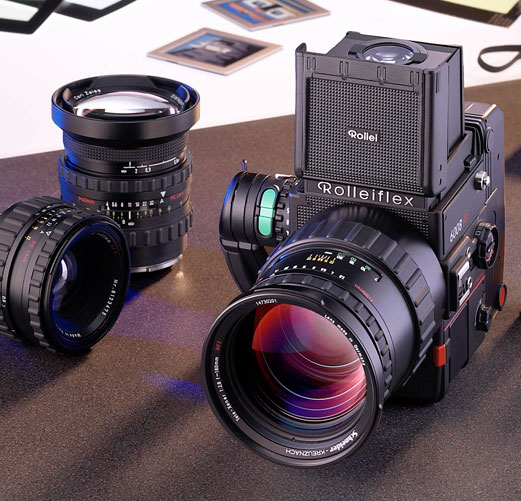 |
 |
Rolleiflex 6008 AF with Schneider AF-Tele-Xenar 180mm lens as featured on a promotion brochure |
Rolleiflex 6008 AF as featured on a promotion brochure |
 |
 |
Side view shows the removable handgrip and waist level finder |
Identical view |
 |
 |
Front view. The two green buttons are release buttons |
Front view without lens. The red button is the lens release |
 |
 |
Left side shows battery, flash hotshoe, switches for metering mode, EV compensation |
Right side shows handgrip, main switch, autofocus mode |
 |
 |
Back of the body without film back |
Back of the body with 6x6 film back attached |
 |
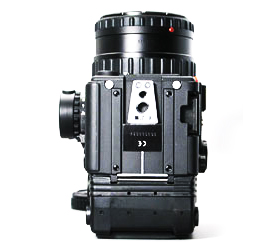 |
6x6 film back and insert |
Bottom of the body |
 |
 |
The camera body's main electronic board |
Autofocus system |
|
 |
Front view with the 45° prism viewfinder attached |
Left side detail with flash hotshoe and metering/EV compensation switch |
 |
 |
Right side detail with main switch as well as the grey memory button |
Same |
 |
 |
Right side detail with the switch for autofocus modes |
Right side detail with the shutter speed dial knob |
 |
 |
Right side detail with handgrip detached |
Masterware software and cable kit for customizing the camera body |
 |
 |
Topside view reveals a large and bright view through the ground glass |
Camera with the Schneider AF-Variogon 60-140mm attached |
 |
 |
45° prism viewfinder |
The 45° prism viewfinder can be turned in different directions |
Information for download
| Sales brochure Rolleiflex 6008 AF / Integral 2 in English | |
| Sales brochure Rolleiflex 6008 AF / Integral 2 in German | |
| Sales brochure Rolleiflex 6008 AF / Integral 2 in Russian | |
| Manual Rolleiflex 6008 AF / Integral 2 in English | |
| Manual Rolleiflex 6008 AF / Integral 2 in German | |
| System brochure Rolleiflex 6000 series in English | |
| System brochure Rolleiflex 6000 series in German | |
| System brochure Rolleiflex 6000 series in Russian | |
| Sales brochure Rolleiflex 6008 AF + PhaseOne DB20p digital bundle in English | |
| Sales brochure Rolleiflex 6008 AF + PhaseOne DB20p digital bundle in Russian | |
| PhaseOne P20 data sheet (=Rollei DB20p) | |
| PhaseOne P series reference manual | |
| Sales brochure Rolleiflex 6008 AF + SinarBack eMotion digital bundle in English | |
| Sales brochure Rolleiflex 6008 AF + SinarBack eMotion digital bundle in Russian | |
| Press release Rolleiflex 6008 AF + SinarBack eMotion digital bundle | |
| RolleiMetric 6008digital metric specifications sheet in English |
Rolleiflex 6008 with Rollei DB20p (PhaseOne P20)
 |
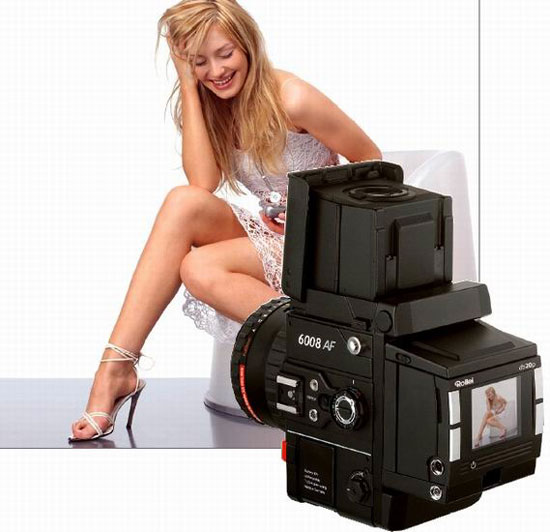 |
Rolleiflex 6008 AF with PhaseOne DB20p digital back |
Rolleiflex 6008 AF with PhaseOne DB20p attached as featured on a promotion brochure |
 |
 |
DB20p kit with hardcase |
DB20p LCD screen |
 |
 |
Rolleiflex 6008 AF with DB20p |
Rolleiflex 6008 AF with DB20p |
 |
 |
DB20p from the side - slot for CompactFlash cards |
Detail of the DB20p digital back with slot for CompactFlash card type II |
Rolleiflex 6008 AF with Sinar digital backs
 |
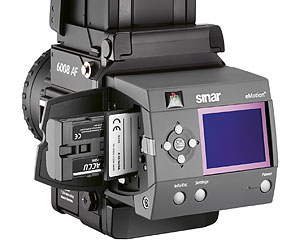 |
Rolleiflex 6008 AF with Sinar eMotion 22 digital back |
Rolleiflex 6008 AF with Sinar eMotion 22 and battery |
 |
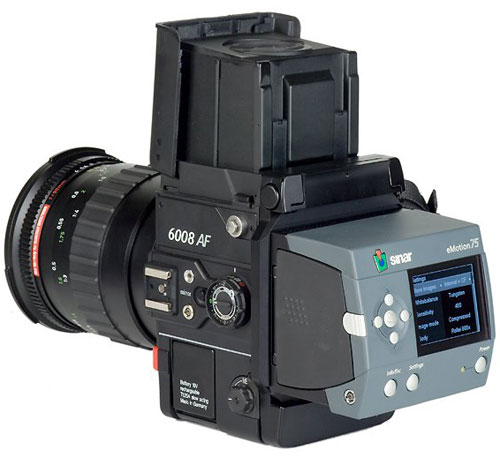 |
Sinar eMotion 75 digital back with battery |
Rolleiflex 6008 AF with Sinar eMotion 75 digital back |
 |
 |
Adapter plate and Sinar eMotion 75 digital back |
Sinar adapter plate |
